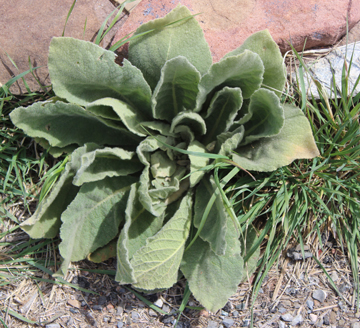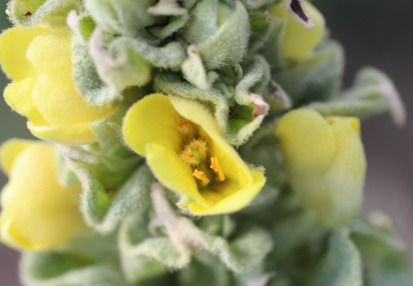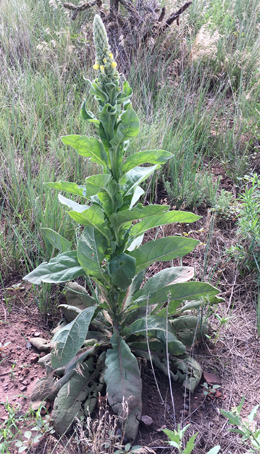
Location
On trail before #8
Flowers first observed: 8/4/17
The Plant Rosette (1st Year)

The Plant w/Flowers (2nd Year)
 |
 |
Flower Spike w/Flowers |
Flower |
Distribution
"Found in disturbed soils on roadsides, waste areas, and burned areas, from 5,000-7,000 ft (1524-2134 m); flowering April-September." (SEINet)
"Common mullein is a nonnative species that occurs throughout most of North America. In Canada, common mullein is found in all southern provinces. In the United States, common mullein occurs in all states including Alaska and Hawaii [7,104,113,139]. Within the contiguous United States, common mullein is often described as common, widespread, conspicuous, or everywhere." (fs.fed.us)
Description
" Biennial herbs with tall, stout, leafy stems to 200 cm tall, herbage densely wooly with branched, nonglandular hairs. Leaves: Cauline leaves elliptic to oblanceolate, 10-40 cm long, clasping with wings extending down the stem, densely wooly on both sides, margins shallowly crenate to almost entire, the first year leaves in a basal rosette. Flowers: Yellow, the corolla rotate, borne in dense, elongate spikes 30 cm long or more, the calyx 5-parted, the lobes lanceolate to ovate, stamens 5, some or all of the filaments bearded, anthers yellow, red, or orange. Fruits: Capsule ellipsoid to subglobose with small brown seeds less than 1 mm long." (SEINet)
Ethnobotanical Uses
Food:
Recipe: Mullein Flower Tea
"Yellow mullein flowers are a great substitute to prepackaged tea. Boil hot water, and steep a spoonful of flowers, covered, for 5 - 10 minutes. Note: Filter though cheesecloth to remove irritation fine hairs.
Variation: Add fresh rose hips or wild rose petals.
(Do not confuse flower buds with seed pods. The seeds are poisonous)" (Morgan 176)
"Dried leaves have been steeped in hot water to make tea, but this tea should always be strained (Warning: This plant is generally considered safe for consumption in reasonable quantities, but it does contain tannin as well as rotenone and coumarin, which are classified as potentially dangerous by the US Food and Drug Administration. Mullein seeds are toxic. The leaf fuzz may irritate sensitive skin and throat membranes.)" (Kershaw 157)
"Leaves and flowers. Although the leaves and flowers are edible, enjoying a cup of tea made from these parts is generally preferable. Leaves and flowers can be used in a salad." (Edible Wild Food)
Medicine:
"People always travel with their medicines, and when European settlers came to America, they brought with them seeds of mullein, a plant they evidently couldn't live without. As the settlers moved west, they shared their home remedies with the native inhabitants, who not surprisingly adopted mullein to their own medicinal needs. Its reputation held it to be effective for many respiratory diseases, and thus it was called 'lung-wort' or 'lung plant.' People smoked the leaves or drank a tea made from the leaves to open bronchial passages when breathing was hampered by asthma or infection. Mullein was also an effective treatment for urinary tract infections, diarrhea, hemorrhoids, and migraine. Settlers even used it to cure ringworm, warts, and frostbite." (Finley and Nieland 118-119)
"The leaves contain large amounts of mucilage, which soothes mucous membranes and has been shown to be an anti-inflammatory. Mullein leaves and flowers were traditionally used to make medicinal teas for treating chest colds, asthma, bronchitis, coughs, kidney infections, diarrhea and dysentery. They were also applied as poultices to ulcers, tumors and hemorrhoids, or they were soaked in oil to make ear drops for curing earaches and killing ear mites. Chopped, dried leaves were smoked to relieve asthma, spasmodic coughing and fevers. Tea made with the stalks was used to treat cramps, fevers and migraine headaches. The roots are said to stimulate urination and to have an astringent effect on the urinary tract, so root tea was taken to tone the bladder, thereby reducing bed-wetting and incontinence. The flowers were soaked in oil to make anti-microbial drops for treating ear infections and removing warts. Mullein-flower tea was said to have a pain-killing , sedative effect." (Kershaw 157)
"It is a mild sedative to the lungs and is especially useful in the initial stages of an infection, when there is mild fever, a raspiness in the throat, and a hot, dry feeling in the chest. --- The flowers are far preferable for more energetic infection, relaxing bronchial spasms and acting as a mild sedative. Boiling water is poured over five to ten of the flowers and steeped in sweetened water and drunk slowly, and repeated as often as needed." (Moore 113)
"(Abnaki) Roots used to make a necklace worn by teething babies. (Atsugewi) Decoction of leaves taken for rheumatism. Decoction of leaves taken for colds. Poultice of pounded, raw leaves applied to cuts. Crushed leaves rubbed over the body during a sweat bath. (Catawba) Poultice of smashed leaves applied to pain. Poultice of smashed leaves applied to swellings, bruises, and wounds. Poultice of smashed leaves applied to sprains. Decoction of roots given to children with croup. (Iroquois) Poultice of heated leaves applied for earaches. Poultice of leaves applied to piles. Poultice of leaves applied to face for mumps. Dried leaves smoked for bad hiccups. Infusion of leaves given to babies to regulate their bowels." (Moerman 590-1)
Other Uses:
"The large, fuzzy leaves provide soft toilet paper (see warning above). They can also be used as padded insoles for foot-weary travelers. Some native peoples smoked the dried leaves (though too much was said to be poisonous) or used mullein smoke to clear the nostrils of horses with colds. The stems and leaves provided lamp wicks (before cotton was used), and dried flower stalks dipped in tallow were burned as torches. The seeds were put into ponds and slow streams as a narcotic fish poison, to stun fish. Roman women used the flowers to make yellow hair dye, and soap made with mullein ashes was said to return gray hair to its previous color." (Kershaw 157)
"The large, velvety-soft leaves are sometimes called 'cowboy's toilet paper' for obvious reasons, and they also make nice shoe liners for foot-sore hikers." (Finley and Nieland 119)
Recipe: Great Mullein Torch
"Great mullein can be dipped in a suet or wax and used as a torch. Melt candle wax, and dip the mullein stalk several times to create multiple wax layers. Let dry in between layers. Take care with open flame, and never leave unattended or burn where there is risk of starting a fire." (Morgan 177)
"(Isleta) Leaves used as a ceremonial tobacco." (Moerman 591)
Internet Links
